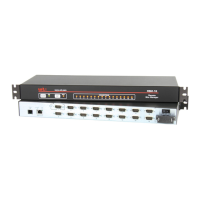4-2
Hardware Installation
4.1.3. DC Powered Units
When connecting a DC Powered TSM Series or RSM Series unit to your DC Power
source, note that the DC terminal block is designed for connection to two separate
power sources. First remove the protective cover from the terminal block, attach the
wires from the -48 VDC power sources to the screw terminals, connect the ground line
to the labeled ground screw, tighten the screw terminals, making certain that the wires
are securely fastened, and then replace the protective cover.
4.2. Connecting the Network Cable
The Network Port is an RJ45 Ethernet jack, for connection to a TCP/IP network.
Connect your 100Base-T cable to the Network Port. Although most TSM/RSM series
units include only one Network Port, note that TSM-DPE series units and RSM-8R8-DE
series units both include two Network Ports.
Note that the TSM/RSM includes a default IPv4 protocol IP address (192.168.168.168)
and a default IPv4 protocol subnet mask (255.255.255.0.) When installing the TSM/RSM
in a working network environment, it is recommended to define network parameters as
described in Section 5.9.
Note:WhenconnectingyournetworkcabletoaTSM/RSMunitthatincludes
twoEthernetports(e.g.,TSM-DPEseriesorRSM-8R8-DEseries)makecertain
toconnecttoPortETH0.
4.3. The Internal Modem Port
If your TSM/RSM unit includes the optional internal modem, connect an RJ11 phone line
to the Internal Modem port. For information on Modem Port configuration, please refer
to Section 5.8. Note that an external modem can also be connected to the TSM/RSM
serial ports as described in Section 4.5, Appendix B and Appendix C.
-48V
-48V -48V00
0.1A
BUS A BUS B
Ground Screw
Figure 4.1: Terminal Block Assembly (TSM Series, DC Units Only)
-48V 0.1A
0
-48V
A
-48V
B
GROUND
SCREW
Figure 4.2: Terminal Block Assembly (RSM Series, DC Units Only)

